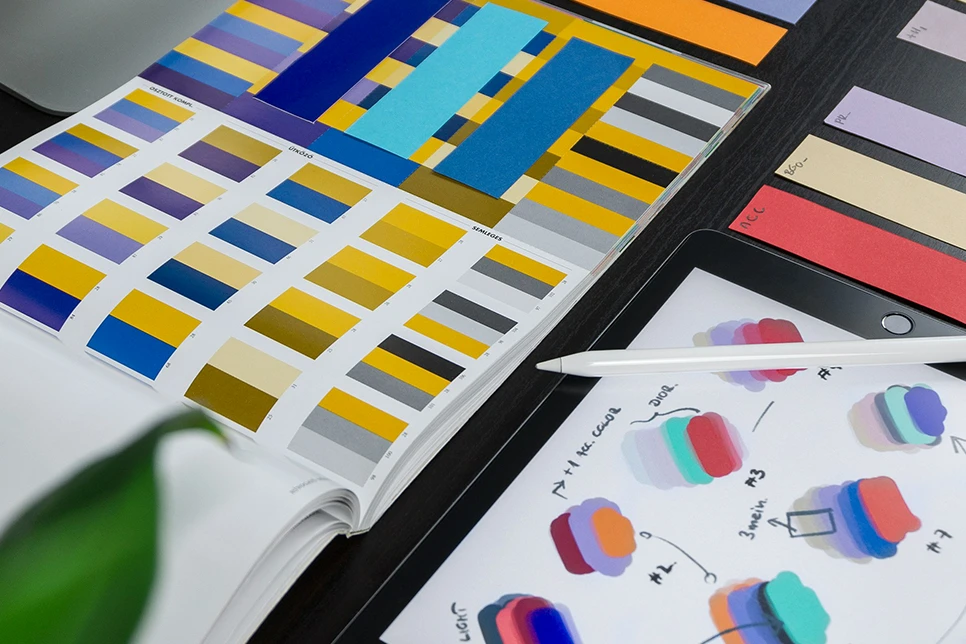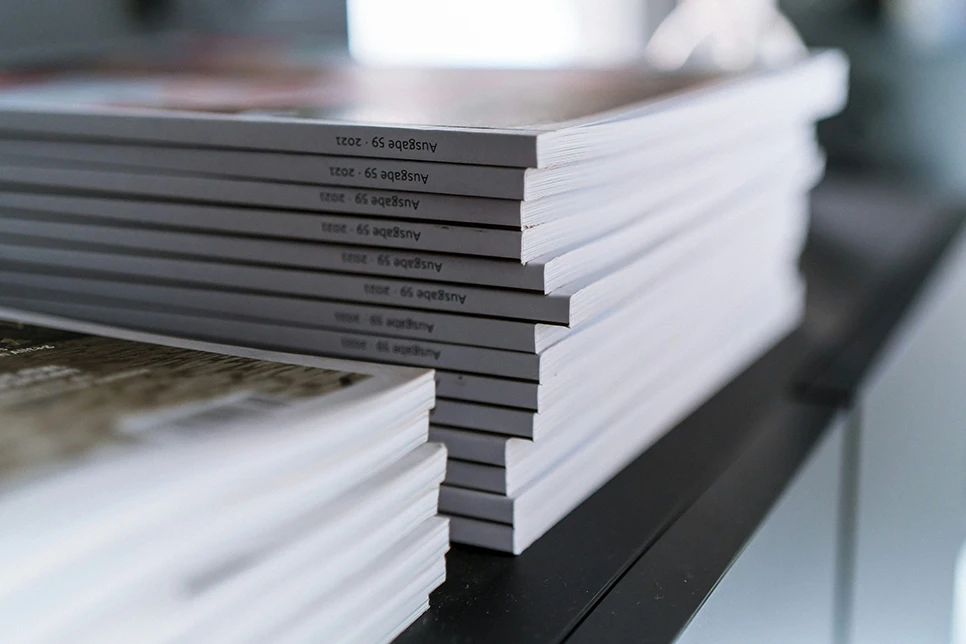Bitmap
An image format that only defines an image in terms of black and white. A bitmapped image is generally used to define line art because its elements can only be black and white, unlike a grayscale image. In general, a bitmapped image will require a higher resolution to render good-quality line art (1000 dpi or higher). A bitmapped image is also known as a 1-bit image.
Color Model
The dimensional coordinate system used to describe colors numerically. Some models include Red, Green, Blue (RGB); Hue, Lightness, Saturation (HLS); Cyan, Magenta, Yellow, Black (CMYK); and Lightness, a, b (Lab).
Color Saturation
The sum of the amounts of ink in a given area of a particular image. In theory, an area of a four-color image that is totally black has a color saturation value of 400 (100C 100M 100Y 100K). Because of dot gain and press conditions, we do not allow a color saturation value above 300.
Color Space
A particular variant of a color model with a specific gamut or range of colors, which is one of its chief characteristics. For example, within the color model RGB are a number of color spaces like Apple RGB, Adobe RGB (1998), and sRGB. Although each of these defines color by the same three axes (R, G, and B), they differ in gamut as well as other specific characteristics.
Combination Halftone (Combo)
An image that comprises elements of both a halftone and line art. The most common occurrences are images where the labeling of the image is outside of the halftone area. The requirements for this particular type of image are that the text be crisp and clear, whereas the quality of the halftone is unchanged. The only way to do this is by combining the properties of the two image types. Preferred format for a combo is a vector graphic EPS. See “EPS.”
Compression Software/Compression Algorithm
A software program or process that physically reduces the data size of an image or a file. It is usually achieved by deleting elements of information for the purposes of compression, then restoring those elements upon decompression. The algorithm is the process, method, or mathematical model used to compress the file.
CMYK (Cyan, Magenta, Yellow, Black)
Four-color printing process that uses the aforementioned inks. It is also known as subtractive color. All color work submitted to CKW must be saved as a CMYK file. Also known as process printing.
Dot Gain
The phenomenon that occurs when ink is transferred from the plate to the blanket of the press and finally to the paper on which it is being printed. A dot for a halftone or a screen gets larger because of the mechanical process of transferring ink. Dot gain can be and is controlled by strict quality measures. The scanning of halftones must be tightly controlled to compensate for dot gain on the press to ensure that halftone quality does not suffer.
DPI (or PPI) or Dots Per Inch/Pixels Per Inch
The resolution of an image or how many pixels are defined in the boundary of a square inch. The more correct term is pixels per inch, but dots per inch is often used instead.
EPS or Encapsulated PostScript
The file format that supports both vector graphics and bitmap images.
An EPS file is usually used for combination artwork or charts and graphs. Generally, an EPS file cannot be edited, except by the software program that created it.
GIF or Graphic Interchange Format
Yet another image format type generated specifically for computer use. Its resolution is usually very low (72 dpi, or that of your computer screen), making it undesirable for printing purposes.
Grayscale
A file created by scanning a continuous tone original and saving the information as shades of gray; also, an image containing a series of tones stepped from white to black.
Halftone
A method of generating on a press or on a laser printer, an image that requires varying densities or shades to accurately render the image. This is achieved by representing the image as a pattern of dots of varying size. Larger dots represent darker areas, and smaller dots represent lighter areas of an image.
Imagesetter
A device that uses laser light to expose film at high dpi resolution, usually 1200 dpi or higher. Most imagesetters have a maximum dpi of 4000. When generating screens or dots for halftones, each dot is created from the smaller dots that are determined by the dpi resolution. Imagesetters come in many different sizes and formats. They can image one page at a time or they can be manufactured large enough to make imposed film for presses.
Indexed Color
A color image format that contains a palette of 256 colors or fewer to define the image. Indexed color can reduce file size while maintaining visual quality. The reduction in file size makes it an ideal format for multimedia or web graphics. It is not used for high-end printing.
Jaggies
The effect caused by images or lines being rendered at too low a resolution. It can easily be defined as a stair-stepped effect giving the line or image a rough appearance. By increasing the resolution, we can reduce the stair-stepped effect. It is important to remember though that once an image has been saved at a lower resolution, it cannot be “rezzed up” to a higher resolution. The resolution will in fact increase, but the quality of the image will not.
JPEG (or JPG) or Joint Photographic Experts Group
JPEG is a standards committee that designed an image compression format. The compression format they designed is known as a lossy compression, in that it deletes information from an image that it considers unnecessary. JPEG files can range from small amounts of lossless compression to large amounts of lossy compression. This is a common standard on the WWW, but the data loss generated in its compression makes it undesirable for printing purposes.
Line Art
Artwork made of solid blacks and whites, with no tonal (gray) values.
LPI or Lines Per Inch
The number of lines per inch on a halftone screen. As a general rule, the higher the lpi, the higher the printed resolution. CKW usually prints journals at 150 lpi.
Moiré
The noticeable, unwanted pattern generated by scanning or rescreening a piece of art that already contains a dot pattern. This effect can also be caused by the misalignment of screen angles in color work.
Monochrome
A single color. Monochrome usually refers to a black-and-white image. Also referred to as line art or bitmap mode (Adobe Photoshop).
Output Resolution
The resolution of the device used for the final output of a digital file expressed as dots per inch (dpi). When printing halftones, the output device is normally a PostScript laser printer or imagesetter. Resolution varies between 300 dpi and 3300 dpi.
PICT
Another type of image format. A PICT file can contain black-and-white, color, or grayscale information, as can a TIFF or EPS file. A PICT image uses a language called QuickDraw to render the graphic. QuickDraw is limited in precision and cannot contain complex curves or special text effects, making a PICT image a bad choice for imagesetting to film or plate. A PICT file is acceptable for a laser printer or low-resolution output.
Pixel
One of the small units that make up an image on a computer or television screen. It is derived from the words “picture” and “element” to make “pixel.”
PNG or Portable Network Graphic
PNG was created as an improved, non-patented replacement for Graphics Interchange Format (GIF), and it is the most widely used lossless image compression format on the Internet. It was designed for the Internet and does not support CMYK, which is needed for printing.
PostScript
A page description programming language created by Adobe Systems Inc. that is a device-independent industry standard for outputting documents and graphics.
Raster
The process of rendering an image or a page using the technology that helped create the television. It involves rendering the particular image or page, pixel by pixel, in a sweeping vertical or horizontal motion, like a rake drawing lines in the dirt.
Rasterized Type
Type that has rough or stair-stepped edges. The type does not appear smooth because it has been rendered at a resolution that is too low.
RGB (Red, Green, Blue)
Color process used by computer displays. The presence of all three colors as light waves is perceived by the eye as white; the absence of light is perceived as black. This is also known as additive color. RGB color is very different from CMYK color. The amount of colors that can be generated by RGB mode is much larger than those that can be generated by CMYK.
PLEASE NOTE: Although graphics created and saved in RGB display well within electronic processes such as the Web, screen displays, the quality will not be guaranteed in print products. All print work submitted in color must be in CMYK to ensure correct color display.
TIFF or Tagged Image File Format
A type of image file format. TIFF files can include color or grayscale information. The quality of the image is determined by its resolution or dpi. If the resolution is too low, the image will appear jagged or have a stair-stepped effect. Once the resolution has been determined, either by scanning or by saving in an image-manipulation software package, it cannot be upgraded or increased to improve quality.
Vector Graphics
Illustrations composed of line and curve segments, created in programs such as Adobe Illustrator and CorelDRAW. These images will typically be EPS and are not resolution-dependent.





